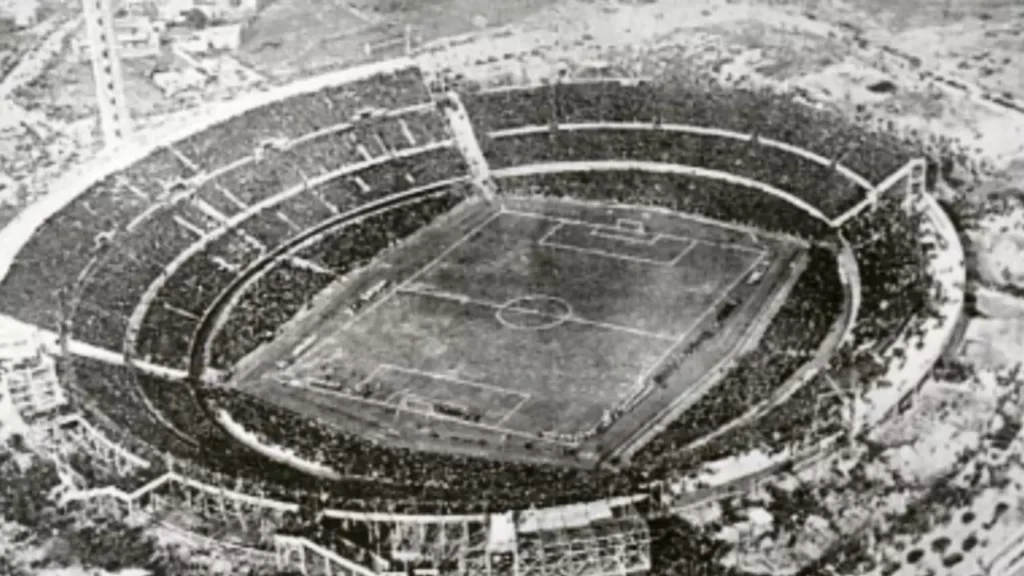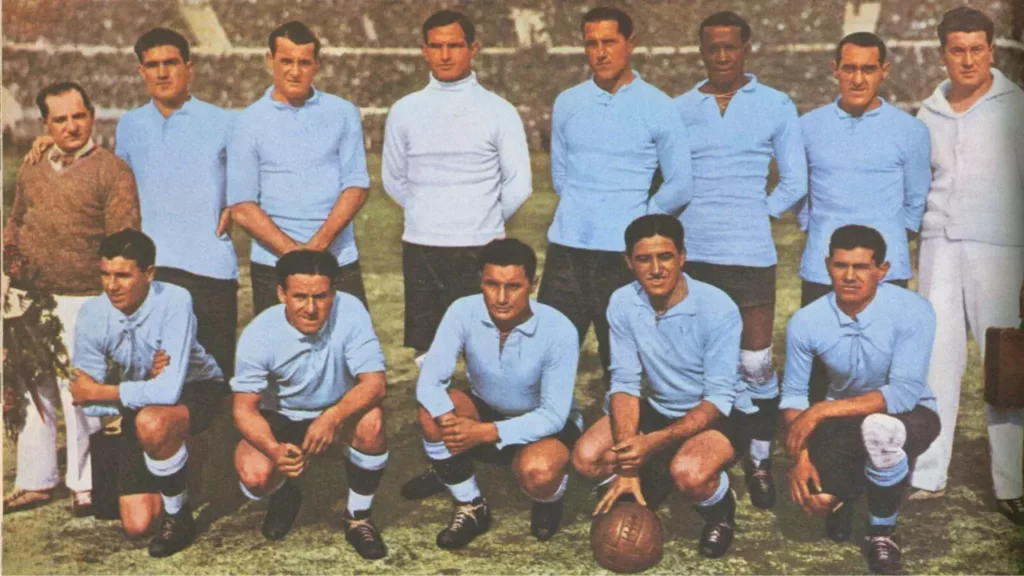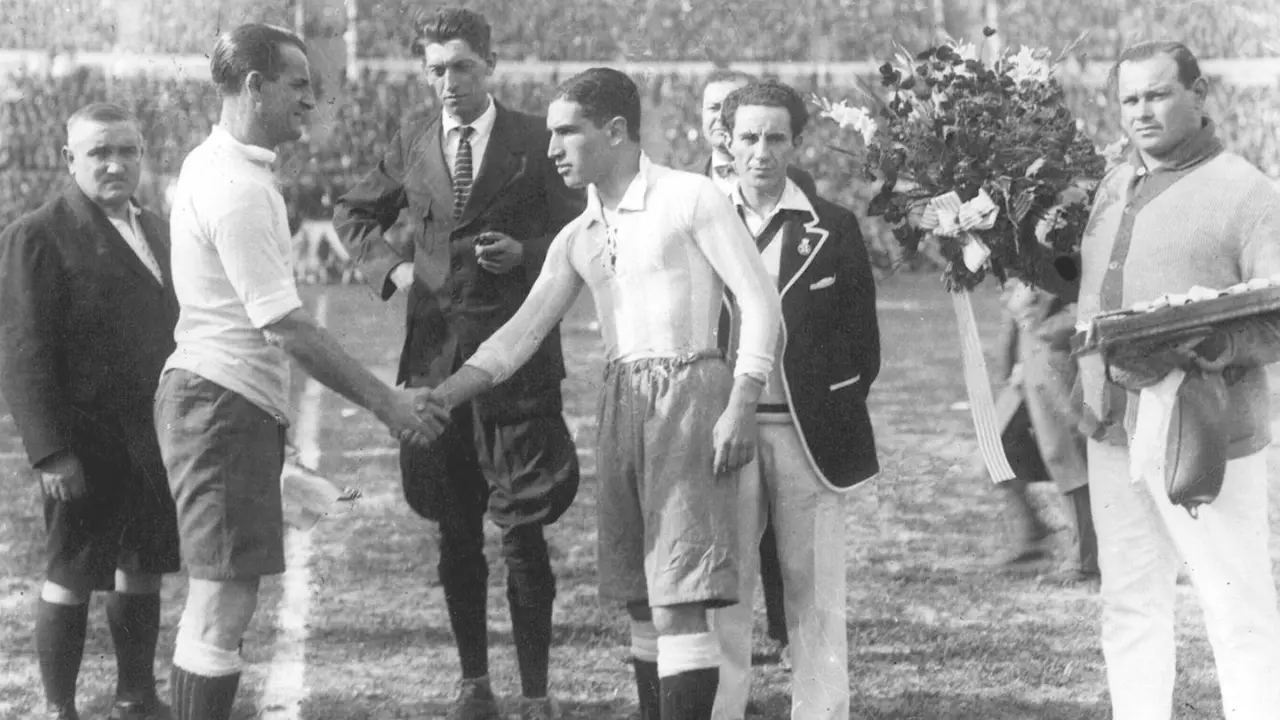1930 WORLD CUP: THE FIRST FOOTBALL WORLD CUP
Conceived by the French visionary Jules Rimet, the 1930 World Cup was the starting signal for the popularisation and professionalisation of football around the world.
However, the first World Cup took place with many controversies and rivalries.
HOW DID THE FIRST WORLD CUP COME ABOUT?
It all started when the International Olympic Committee (IOC) announced that football would not be part of the 1932 Olympic Games, due to its lack of popularity in the United States, the host country for the event.
FIFA did not agree with this exclusion, as it wanted to professionalise the sport.
In 1928, Monsieur Jules Rimet, the French president of FIFA at the time, announced the creation of a tournament that would also be held every four years, but now exclusively for football: the World Cup.
URUGUAY: HOST COUNTRY FOR THE 1930 WORLD CUP

With five candidate countries, FIFA chose the capital city of Montevideo, Uruguay, to host the first FIFA World Cup.
This choice was no coincidence: it was the centenary year of the country’s independence and the Uruguayan national team had won the last two Olympic football titles.
Despite the tribute, this decision caused some problems in the organisation of the event.
CONTROVERSIES AND THE START OF THE 1930 WORLD CUP
The choice of Uruguay, a South American country, caused several countries to drop out of the competition due to the cost and length of the trip.
It is important to remember that football was still considered an amateur sport and did not receive adequate investment.
COUNTRIES PARTICIPATING IN THE 1930 WORLD CUP
Thus, only 13 teams participated in the event, without knockout matches: four from Europe (France, Belgium, Romania and Yugoslavia), seven from South America (Brazil, Argentina, Bolivia, Uruguay, Paraguay, Chile and Peru) and two from North America (USA and Mexico).
The first World Cup was held from 13 to 30 July 1930 in a harsh winter. It was divided into four groups, with Argentina, the United States, Uruguay and Yugoslavia qualifying for the semi-finals.
THE FIRST GOAL AT THE WORLD CHAMPIONSHIPS
France’s Lucien Laurent scored the first goal in the history of the World Cup in the 19th minute against Mexico at the Pocitos Stadium.
THE 1930 WORLD CUP FINAL
The end of the first World Cup took place on 30 July 1930, in the legendary Centenario Stadium in Montevideo, which was ready when the World Cup had already started.
Argentina and Uruguay were repeating the decisive football clash of the 1928 Summer Olympics, in which Uruguay won 2-1.
BEFORE THE FINAL MATCH OF THE 1930 WORLD CUP
There were some peculiar developments before the final.
The two finalist teams could not agree on who should start the match and which ball would be used, which forced the federation to intervene and decide that the Argentine team would start the match and provide the ball in the first half and the Uruguayans would provide the ball and start the match in the second half.
Luis Monti, played in the final with Argentina despite receiving death threats on the eve of the match.
The referee was the Belgian John Langenus, who only agreed to referee a few hours before the match, having sought assurances for his safety.
One of his requests was for a boat to be ready in port an hour after the final whistle, in case he needed to make a quick getaway.
DURING THE FINAL MATCH OF THE 1930 WORLD CUP
Uruguay scored first through Pablo Dorado after a low shot on goal.
After eight minutes, Carlos Peucelle, receiving a pass from Ferreira, scored and tied the match.
Just before half-time, Guillermo Stabile, the tournament’s top scorer, scored to turn the score around (2-1) for Argentina.
Uruguay captain José Nasazzi protested. Claiming that Stábile was offside, but the goal was upheld by the referee.
In the second half, Uruguay grew into the game. Shortly after Argentina almost took the lead, Uruguay counterattacked and José Pedro Cea tied the game again at 2-2.
Ten minutes later, Santos Iriarte scored to put the game back in Uruguay’s favour.
And just before the end of the match, Héctor Castro, scored the last goal, closing the score to 4-2 for Uruguay.
With a crowd of 93,000 and a 4-2 result, Uruguay became the first World Cup champions, receiving the famous Jules Rimet Cup.
AFTER THE FIRST WORLD CUP FINAL IN 1930
The following day was declared a public holiday in Uruguay, while in the Argentine capital, Buenos Aires, a mob threw stones at the Uruguayan embassy.
Francisco Varallo, who played as a striker for Argentina, was the last player in the final to die, on 30 August 2010.
With eight goals, Guillermo Stábile was the tournament’s top scorer.

AFTER THE FIRST CUP FINAL
The following day was declared a national holiday in Uruguay, while in the Argentine capital Buenos Aires, a crowd threw stones at the Uruguayan embassy.
Francisco Varallo, who played as a striker for Argentina, was the last player of the final to die, on August 30, 2010.
With eight goals, Guillermo Stábile, was the top scorer of the tournament.
FINAL STANDINGS OF THE FIRST WORLD CUP
Uruguay was the grand champion, with Argentina in second place, the United State16 Curiosities of the World Cups in third, Yugoslavia in 4th, Chile in 5th and Brazil in 6th.
World Cup Series:
- 16 Curiosities of the World Cup
- Episode 01: World Cup of 30
- Episode 02: World Cup of 34
- Episode 03: World Cup of 38
BIBLIOGRAPHIC REFERENCES
DUARTE, Orlando. Encyclopedia: All World Cups. Sao Paulo: Makron Books, 1998.
FIFA. 1930 FIFA World Cup Uruguay. Available at: <http://www.fifa.com/worldcup/archive/uruguay1930/index.html>. Accessed on: 01/08/2018
